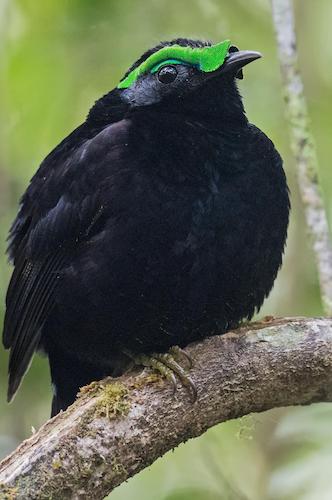Philepittidae – Asities

The Philepittidae or asities and sunbird-asities are a family of birds that are endemic to Madagascar. They consist of four species in two genera. The Neodrepanis species are known as sunbird-asities and were formerly known as false sunbirds. They were formerly included with the broadbills.
Some authors have placed the sapayoa of South America in this family, or with the Broadbills, although it is now considered by many to be in its own family, the Sapayoidae.
Asities are small forest birds with sexually dichromic plumage and brightly coloured wattles around the eyes of the males. These wattles, which are most conspicuous during the breeding season, get their colour from arrays of collagen fibres. This method of pigmentation is unique in the animal kingdom. Several other features separate them from the broadbills, they possess twelve tail feathers on extremely short (almost non-existent in the Philepitta species) tails, their syrinx is encased with a large bronchial ring and they have forked tongues adapted to nectivory. They have a long outer primary which buzzes in flight, possibly used in signalling during courtship. The two genera are quite distinct.
The major component of the diet of asities is fruit. A wide range of different fruit is taken by the family, and they are among the most important avian dispersers of seeds, as there are very few other frugivorous birds in the forests of Madagascar. They will also take insects. The Neodrepanis sunbird-asities will sometimes take nectar, but do so with a long tongue rather than inserting their curved bills far into flowers.
Rainforest asities breed during the Malagasy rainy season, beginning just before the rains in September to November. The velvet asity begins breeding slightly sooner in the north of its range. That species is the only one for which detailed information about breeding is available. It has a polygynous breeding system, with males holding small territories or leks where they display to passing females. Nest building and raising the young is incubation solely by the females. There are reports of yellow-bellied sunbird-asities feeding young in the nest and recently fledged chicks, so there is clearly some variation in breeding strategies in the family. The nests of the family are elaborate; pear-shaped woven structures hanging from branches, similar to those of broadbills, although uniquely amongst birds which weave nests the entrance to the nest is pushed created by pushing through the wall after constructed (instead of the usual scenario where the entrance is weaved into the fabric of the nest).
There are just four species in this family, listed below.
Velvet Asity Philepitta castanea
Schlegel’s Asity Philepitta schlegeli
Common Sunbird-Asity Neodrepanis coruscans
Yellow-bellied Sunbird-Asity Neodrepanis hypoxantha
-
Common Sunbird-Asity Neodrepanis coruscans
Conservation Status -
Common Sunbird-Asity Neodrepanis coruscans
Species AccountThe common sunbird-asity or sunbird asity (Neodrepanis coruscans) is a species of bird in the family Philepittidae. It is endemic to Madagascar. Its natural habitat is subtropical or tropical moist lowland forests. -
Schlegel's Asity Philepitta schlegeli
Species AccountSchlegel's asity (Philepitta schlegeli) is a species of bird in the family Philepittidae. It is endemic to Madagascar. -
Velvet Asity Philepitta castanea
Species AccountThe velvet asity (Philepitta castanea) is a species of bird in the family Philepittidae. It is endemic to Madagascar. -
Yellow-bellied Sunbird-Asity Neodrepanis hypoxantha
Species AccountThe yellow-bellied sunbird-asity (Neodrepanis hypoxantha) is a small species of passerine bird from the asity family. -
Yellow-bellied Sunbird-Asity Neodrepanis hypoxantha
Distribution and Calls
-
Wikipedia
https://en.wikipedia.org/wiki/Asity
-
Number of bird species: 4
